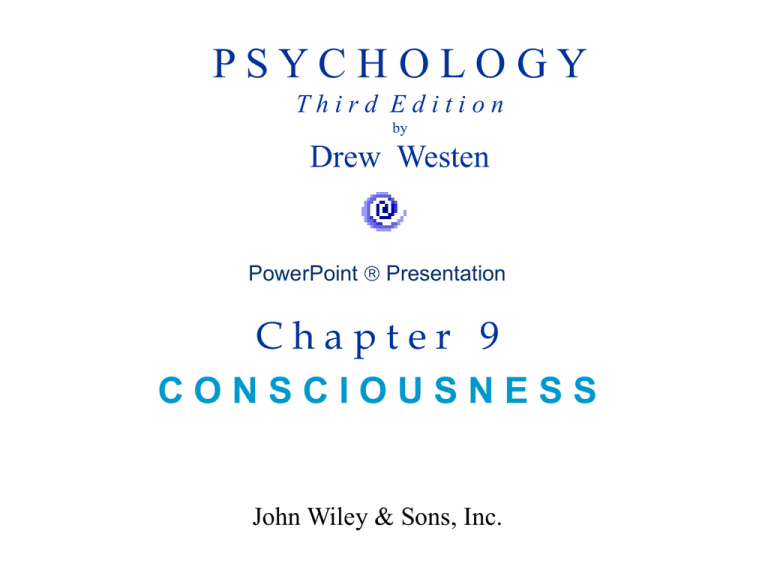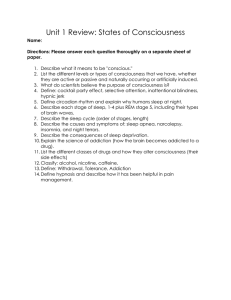
PSYCHOLOGY
Third Edition
by
Drew Westen
PowerPoint Presentation
Chapter 9
CONSCIOUSNESS
John Wiley & Sons, Inc.
Lecture Outline
Nature of Consciousness
Perspectives on Consciousness
Sleep and Dreaming
Altered States of Consciousness
© 2002 John Wiley & Sons, Inc.
Consciousness
William James (1890):
Consciousness is a constantly moving stream of
thoughts, feelings, and emotions
Consciousness can be viewed as our subjective
awareness of mental events
Functions of consciousness:
Monitoring mental events
Control: consciousness allows us to formulate and
reach goals
Consciousness may have evolved to direct or
control behavior in adaptive ways
© 2002 John Wiley & Sons, Inc.
Cortex and Consciousness
The dorsolateral prefrontal cortex is
activated during conscious control tasks
Subjects asked to name the ink color in the
Stroop task below have difficulty when the
word name and color are different
This color-naming task was associated with
activation of the dorsolateral prefrontal cortex
© 2002 John Wiley & Sons, Inc.
Attention
Our conscious awareness is limited in capacity
and we are aware of only a small amount of the
stimuli around us at any one time
Attention refers to the process by which we focus
our awareness
Three functions of attentional processes:
Orienting function toward the environment
Control of the content of consciousness
• I will think about this issue but not that one…
Maintaining alertness
© 2002 John Wiley & Sons, Inc.
Divided Attention
Divided attention refers to a
task in which a person is
asked to attend to two tasks
at the same time
Subject may be asked to listen
to one conversation
(shadowing) delivered via the
left ear
Some information on the other
channel (right ear) is
processed (as shown in
priming tasks)
© 2002 John Wiley & Sons, Inc.
Flow of Consciousness
Day-dreams are shifts in attention
toward internal thoughts and imagined
scenarios
College students may spend as much as
50% of their waking time in a day-dream
(uhh, are you folks paying attention out
there????)
Beeper studies of high-school students
have noted the predominance of negative
thoughts when students are with their
families as opposed to others
© 2002 John Wiley & Sons, Inc.
Psychodynamic View of
Consciousness
Freud argued that three mental
systems form consciousness
Conscious: mental events that you
are aware of
Preconscious: Mental events that
can be brought into awareness
Unconscious: Mental events that are
inaccessible to awareness; events
are actively kept out of awareness
© 2002 John Wiley & Sons, Inc.
Subliminal Perception
Notion that brief exposure to sub-threshold
stimuli can influence awareness
Study: subjects are shown aggressive (A) or
positive (B) stimuli
and then rate a neutral stimulus (C)
Subjects shown panel A first subsequently rated the
boy in panel C more negatively
© 2002 John Wiley & Sons, Inc.
(Figure adapted from Eagle, 1959)
Unconscious Cognitive Processes
Information-processing view can be extended to
analyses of unconscious processes
Notion is that many brain mechanisms operate
in parallel
Some of these mechanisms operate outside of the
level of consciousness
Functional significance of unconscious
mechanisms:
Are efficient and rapid
Can operate simultaneously
Operate in the absence of consciousness?
© 2002 John Wiley & Sons, Inc.
Blindsight
People with damage to the central portion
of the occipital cortex
are blind in the sense that they are unable to
see objects placed before them
are able to provide partial information about
the geometric shape of an object (blindsight)
Blindsight may involve a primitive visual
system in the midbrain
© 2002 John Wiley & Sons, Inc.
Neurology of Consciousness
Consciousness is distributed
throughout the brain
Hindbrain and midbrain are
important for arousal and for
sleep
Damage to the reticular
formation can lead to coma
Prefrontal cortex is key for
conscious control of
information processing
© 2002 John Wiley & Sons, Inc.
Sleep and Dreaming
Behavioral characteristics of sleep
Minimal movement
Stereotyped prone posture
Require a high degree of stimulation to
arouse organism
Physiological characteristics of sleep
Brain wave activity (seen in the EEG)
Paralysis of muscles (seen in the EMG)
Cardiovascular changes (alternating cycles
of arousal)
© 2002 John Wiley & Sons, Inc.
Species Variation in Sleep
(Figure adapted from Kripke et al., 1979)
© 2002 John Wiley & Sons, Inc.
Function of Sleep
Memory consolidation
Energy conservation
Preservation from predators
Restoring bodily functions
Sleep deprivation can alter immune
function and lead to early death
Sleep deprivation can also lead to
hallucinations and perceptual disorder
© 2002 John Wiley & Sons, Inc.
Mortality Rates and Sleep
(Figure adapted from Kripke et al., 1979)
© 2002 John Wiley & Sons, Inc.
EEG Stages of Sleep
(Figure adapted from Cartwright, 1978)
© 2002 John Wiley & Sons, Inc.
REM Sleep
Characteristics of REM sleep
Presence of rapid-eye-movements
Presence of dreaming
Increased autonomic nervous system activity
EEG resembles that of awake state (beta
wave)
Motor paralysis (except for diaphragm)
© 2002 John Wiley & Sons, Inc.
Dreaming
Psychoanalytic view: Dreams represent a window
into the unconscious
The latent content (meaning) can be inferred from the
manifest content (the actual dream)
Cognitive view: Dreams are constructed from the
daily issues of the dreamer
Biological view: Dreams represent the attempt of
the cortex to interpret the random neural firing of
the brain during sleep
© 2002 John Wiley & Sons, Inc.
Sleep Disorders
Insomnia is the inability to achieve or maintain
sleep
Many causes for insomnia:
Stress
Depression
Sleeping pills (iatrogenic means physician-caused)
Some suggestions for treating insomnia
Only use your bed for sleeping
Avoid physical activity prior to sleep
Avoid consumption of caffeine and alcohol before bed
Keep a regular sleep schedule
Go to bed when you are ready(do not force sleep)
Do not sleep during the day if you have insomnia
© 2002 John Wiley & Sons, Inc.
Other Sleep Disorders
Nightmares are vivid fear-evoking dreams
Occur during REM sleep
Night Terrors: are episodes of intense panic
Occur during delta sleep (early in night)
Sleep apnea: refers to awakening brought on by
cessation of breathing during sleep
Narcolepsy: falling asleep during the day
© 2002 John Wiley & Sons, Inc.
Altered States of Consciousness
Changes in consciousness can be
brought on by
Meditation
Hypnosis
Drug ingestion
Religious experiences
© 2002 John Wiley & Sons, Inc.
Hypnosis
Hypnosis is a state of consciousness
characterized by
Deep relaxation
Suggestibility
Effects observed during hypnotic state:
Age regression
Change in pain perception
Ability to recall memories into consciousness
© 2002 John Wiley & Sons, Inc.
Changes in Pain Perception
during Hypnosis
Hilgard’s
demonstration of the
“Hidden Observer”
Subjective pain report
depends on the aspect
of consciousness that
is reporting on pain
(Figure adapted from Hilgard, 1986, p. 190)
© 2002 John Wiley & Sons, Inc.
Drug-Induced States of
Consciousness
Drug effects on consciousness depend on:
Biological actions of the drug
• Usually involve drug action at brain synapses
Expectations of drug effect (what effect are you
expecting from the drug?)
Drug classes
Depressants (including alcohol)
Stimulants (amphetamine, cocaine)
Hallucinogens (LSD)
Marijuana
© 2002 John Wiley & Sons, Inc.
Copyright
Copyright 2002 by John Wiley & Sons, Inc., New
York, NY. All rights reserved. No part of the
material protected by this copyright may be
reproduced or utilized in any form or by any means,
electronic or mechanical, including photocopying,
recording, or by any information storage and
retrieval system, without written permission of the
copyright owner.
© 2002 John Wiley & Sons, Inc.





